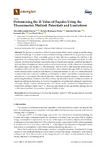Mostrar o rexistro simple do ítem
Determining the U-Value of Façades Using the Thermometric Method: potentials and limitations
| dc.contributor.author | Bienvenido Huertas, José David | |
| dc.contributor.author | Rodríguez-Álvaro, Roberto | |
| dc.contributor.author | Moyano, Juan | |
| dc.contributor.author | Rico Delgado, Fernando | |
| dc.contributor.author | Marín García, David | |
| dc.date.accessioned | 2018-05-28T18:36:56Z | |
| dc.date.available | 2018-05-28T18:36:56Z | |
| dc.date.issued | 2018 | |
| dc.identifier.citation | Bienvenido-Huertas, D.; Rodríguez-Álvaro, R.; Moyano, J.J.; Rico, F.; Marín, D. Determining the U-Value of Façades Using the Thermometric Method: Potentials and Limitations. Energies 2018, 11, 360. | es_ES |
| dc.identifier.uri | http://hdl.handle.net/2183/20758 | |
| dc.description | Estudo financiado polo V Plan Propio de Investigación da Universidade de Sevilla (2013-2016) | es_ES |
| dc.description.abstract | [Abstract:] The thermal transmittance of building envelopes determines to a large extent the energy demand of buildings. Thus, there is a keen interest in having methods which can precisely evaluate thermal transmittance. From a scientific point of view, this study analyses the viability of the application of the thermometric method (THM), one of the most used methods in Spain. For this purpose, the test method has been improved by determining the adequate test conditions, the selection and installation of equipment, data acquisition and post-processing, and the estimation of uncertainty. We analyse eight case studies in a Mediterranean climate (Csa) to determine the potentials and limitations of the method. The results show that the values obtained through THM are valid under winter environmental conditions with relative uncertainties between 6% and 13%, while difficulties to perform the test in optimal conditions, and therefore to obtain valid results in warmer seasons, are detected. In this regard, the case studies which obtained a greater number of observations by performing the filtrate conditions were able to obtain representative results. Furthermore, there are significant differences depending on the kind of equipment and probes used during the experimental campaign. Finally, in warm climate regions a data filtrate can be considered for observations of a temperature difference higher than 5 ◦C, obtaining valid results for the case studies, although the rise in the thermal gradient can guarantee a greater stability of data. | es_ES |
| dc.language.iso | eng | es_ES |
| dc.publisher | MDPI | es_ES |
| dc.relation.uri | https://doi.org/10.3390/en11020360 | es_ES |
| dc.rights | Atribución 3.0 España | es_ES |
| dc.rights.uri | http://creativecommons.org/licenses/by/3.0/es/ | * |
| dc.subject | Thermal transmittance (U-value) | es_ES |
| dc.subject | Thermometric method (THM) | es_ES |
| dc.subject | Façades | es_ES |
| dc.subject | Internal convective coefficient | es_ES |
| dc.subject | In situ measurement | es_ES |
| dc.title | Determining the U-Value of Façades Using the Thermometric Method: potentials and limitations | es_ES |
| dc.type | info:eu-repo/semantics/article | es_ES |
| dc.rights.access | info:eu-repo/semantics/openAccess | es_ES |
| UDC.journalTitle | Energies | es_ES |
| UDC.volume | 11 | es_ES |
| UDC.issue | 2 | es_ES |
| UDC.startPage | 1 | es_ES |
| UDC.endPage | 17 | es_ES |
| dc.identifier.doi | 10.3390/en11020360 |






